After a dazzling, all-Russian program for our Opening Night Concert, featuring Yefim Bronfman performing Rachmaninoff’s Piano Concerto No. 3, we continue to explore the music of the Tsars’ realm when Music Director Andrés Orozco-Estrada returns to conduct our first Classical Series concert of the 2019–20 Season: Stravinsky’s Firebird, September 19, 21, and 22. In this post (a revised and expanded version of an earlier one), discover how Stravinsky and his collaborators created the ultimate Russian fairytale ballet. Visit houstonsymphony.org for tickets and more information.
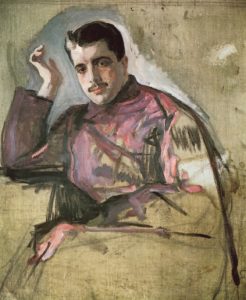
In 1909, the Russian impresario Sergei Diaghilev was running out of time. After a key backer of his ventures dropped dead, Diaghilev had been forced to abandon his plans to present Russian opera in Paris in the spring of 1910. Instead, he would present the more cost-effective art form of ballet.
FOR RUSSIAN EXPORT
In recent years, Paris had been swept by a vogue for all things Russian, and Diaghilev was quick to capitalize on the trend with performances of Russian operas, ballets and concert music. While some of what he produced was merely crowd pleasing, he also hoped Paris would give him an opportunity to put his theories about art into practice.
Before Paris, Diaghilev had been the leader of one of Russia’s most prominent arts publications, Mir Iskusstva, or “The World of Art,” which had advocated for a hedonistic “art for art’s sake” aestheticism that opponents decried as decadence. The Miriskusniki, as these aesthetes were known, preferred stylization to realism, fairytales to social commentary, primal emotions and sensuality to detached rationality, and above all the pursuit of beauty to moralizing. They dreamed of creating an overwhelming, totally integrated work of art with music, theater, and visual design that would be fresh yet rooted in the soil of primeval Russia. Their chosen mascot was a character from Russian folklore that symbolized rebirth, beauty, and magic: the Firebird. Thus, the highlight of Diaghilev’s 1910 Paris season would be The Firebird, a new ballet that would realize his ideals and show the world that Russian art was at the cutting edge of sophistication.
THE MAN FOR THE JOB

For The Firebird, Diaghilev originally planned to hire a composer with whom he had worked before, Alexander Tcherepnin, but he dropped out. Next Diaghilev turned to Anatoly Lyadov, but he also fell through, possibly because the project came at such short notice. Diaghilev briefly considered Alexander Glazunov, then Russia’s leading composer, but he didn’t bite. Running out of options, he turned to a young, relatively untested composer who had orchestrated two pieces by Chopin for a Diaghilev ballet the year before: Igor Stravinsky. A former student of the great Rimsky-Korsakov, Stravinsky would at least be technically proficient, and being little-known, he would likely say yes to anything.
Diaghilev was right. Stravinsky got to work even before Diaghilev had made him a formal offer, though most of his initial sketches had to be discarded as the details of the ballet’s plot and structure morphed. Eager to make the ballet as Russian as possible, Diaghilev’s team concocted a story that combined the most famous characters from half-a-dozen Russian fairytales, including the Firebird, Prince Ivan-Tsarevich, thirteen dancing princesses and the evil sorcerer-king Kashchey the Deathless. This particular cast was undoubtedly inspired by an excerpt from Polonsky’s famous poem, “A Winter’s Journey,” which Russian children still recite today:
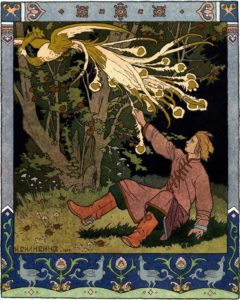
…And in my dreams I see myself on a wolf’s back
Riding along a forest path
To do battle with a sorcerer-tsar
In that land where a princess sits under lock and key,
Pining behind massive walls.
There gardens surround a palace all of glass;
There Firebirds sing by night
And peck at golden fruit;…
Stravinsky worked directly with the choreographer Michel Fokine, who like virtually all ballet masters before him believed that music should be written to fit the dancing, not the other way around. Even so, he was particularly hands on, dictating many details of how Stravinsky’s music would unfold. Fokine later recalled a scene that gives some sense of their working method:
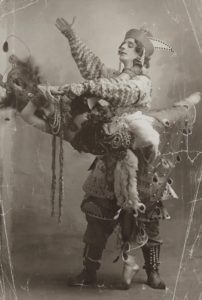
“I remember how he brought me a beautiful Russian melody for the entrance of Ivan-Tsarevich. I suggested not presenting the complete melody all at once, but just a hint of it, by means of separate notes, at the moments when Ivan appears at the wall, when he observes the wonders of the enchanted garden, and when he leaps over the wall.
“Stravinsky played, and I interpreted the role of Tsarevich, the piano substituting for the wall. I climbed over it, jumped down from it, and crawled, fear-struck, looking around—my living room. Stravinsky, watching, accompanied me with patches of the Tsarevich melodies, playing mysterious tremolos as background to depict the garden of the sinister Kashchey the Deathless…”
As the most junior member of the creative team, Stravinsky put up with Fokine’s caprices and wrote the music to his requirements. It is a testament to the 27-year-old composer’s burgeoning genius that even so the score turned out to be one of the young century’s iconic masterpieces.
The son of one of Russia’s leading opera singers, Stravinsky grew up surrounded by music, although he only began to pursue it seriously at 17, when he began studying privately with Rimsky-Korsakov, Russia’s most prominent living composer. In this ballet, the first major work Stravinsky completed after his teacher’s death in 1908, Stravinsky would put Rimsky-Korsakov’s musical language to work in a Miriskusniki ballet; though Rimsky-Korsakov might have looked askance at the Miriskusniki’s decadent ideas, The Firebird is in some ways the great ballet Rimsky-Korsakov never wrote. The premiere on June 25, 1910 caused a sensation and catapulted Stravinsky to international fame.
THE MUSIC
In a tradition stretching back to Glinka’s opera Ruslan and Lyudmila (1842), Russian composers used strange, chromatic scales and harmonies to depict supernatural forces and simpler, more “natural” folk melodies to represent human characters. Stravinsky continues this tradition throughout The Firebird, starting with the sepulchral opening for cellos, basses and bass drum:
After an introduction, the curtain rises on the magic garden of Kashchey the Deathless. Shrouded in darkness, knights and princes who have turned to stone lie on one side, a golden gate that leads to Kashchey’s castle on the other. In the center is a tree that bears golden apples.
All at once, a brilliant, fluttering crescendo and descrescendo passes through the orchestra as the Firebird flies through the garden, briefly illuminating it with a blinding light. In pursuit is Ivan Tsarevich, represented by a solo horn playing fragments of a Russian folk song just as Fokine described above. Throughout the ballet, Ivan is associated with the noble sound of this instrument.
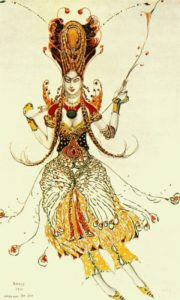
The Firebird soon reappears for her dance, well-known from the suite Stravinsky extracted from the ballet in 1919. A brief pause in the music marks the end of the dance. Ivan then catches the Firebird by surprise. After a brief struggle, the Firebird recognizes that she has been captured, and she and the Prince dance together as she pleads with him to let her go. This dance of the Firebird’s supplication begins with a sensuous, exotic melody for solo oboe, English horn, and viola; a contrasting middle section features a brittle accompaniment from cellos and basses played col legno (with the wood of the bow). After a reprise of the sensuous supplication melody, the dance ends and Ivan allows the Firebird to go free. In gratitude, she gives him one of her feathers, telling him that she will soon return his kindness.
Ivan contemplates this gift accompanied by a characteristic horn solo, until the grotesque music of Kashchey’s garden resumes. Ivan is about to leave this place when high violins and lyrical woodwind solos signal the entrance of the thirteen princesses who are Kashchey’s prisoners. Ivan hides, and the youngest and fairest of the princesses shakes some golden apples from the tree (illustrated by tremolo strings and a cymbal). Fast, fluttering music (not unlike that Stravinsky wrote in his Scherzo fantastique) then accompanies the princesses’ game with the golden apples.
This music comes to an abrupt stop when Ivan reveals himself. He introduces himself to the princesses accompanied by his solo horn, and they are so taken with him that they invite him to dance a korovod, or round dance (another famous selection included in the 1919 suite). In a tribute to his teacher, Stravinsky took the melody of the dance from a traditional Russian folk song that Rimsky-Korsakov also used in his Sinfonietta.
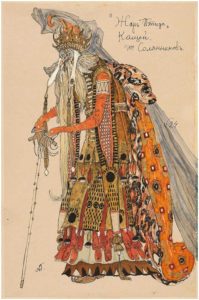
By the end of the dance, Ivan and the youngest princess have fallen in love, but their kiss is interrupted by trumpet calls that announce that the princesses must return to Kashschey’s palace. Ivan and the princess reluctantly part, but no sooner has she left than Ivan determines to rescue her from the castle. As soon as he touches the golden gate, however, magic alarm bells ring out, and Kashchey’s demonic retinue captures him. Kashchey himself appears with a thunderous roll from the timpani and bass drum. He confronts Ivan for trespassing, but Ivan spits at the evil sorcerer, much to his displeasure. The princesses intercede on Ivan’s behalf with their characteristic woodwind solos, but to no avail. After a pause, Kashchey begins to turn Ivan to stone with rumbling waves of sound from the depths of the orchestra.
Before it is too late, Ivan remembers the Firebird’s feather and summons her. Her flaming music signals her return, and she uses her magic to make Kashchey and his minions dance. The famous Infernal Dance (also included in the 1919 suite) is another musical tribute; it borrows its main melody from a passage in Rimsky-Korsakov’s opera Mlada that represented a witches’ sabbath. Stravinsky’s genius for rhythm, however, transforms the idea with syncopations and a series of musical lightning bolts that startled many unsuspecting attendees of the Paris premiere.
Exhausted from the dance, Kashschey and his creatures fall into a deep slumber, and the Firebird begins her lullaby with a haunting melody for bassoon. At the end of the lullaby, Kashchey awakens, but the Firebird shows Ivan where to find the egg that holds his soul. He tosses it from side to side accompanied by a lurching orchestra, and then smashes it, killing Kashchey and undoing his evil magic (the legend of Kashchey the Deathless’s egg likely inspired J. K. Rowling’s horcruxes).
The resplendent finale begins with a horn solo based on a melody from a collection of folk songs that Rimsky-Korsakov had published (Tchaikovsky had also arranged the same melody for two pianos). The theme is repeated, building to an exhilarating ending. The chromatic chords that end the ballet outline the Firebird’s motif, bringing the ballet to a magical conclusion. —Calvin Dotsey
Don’t miss Stravinsky’s Firebird, September 19, 21, and 22. Visit houstonsymphony.org for tickets and more information.



